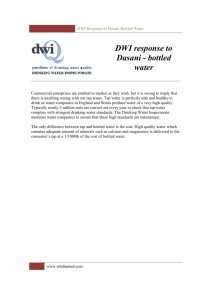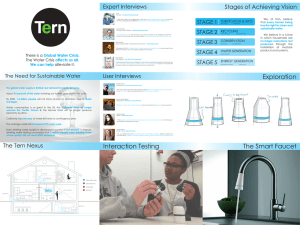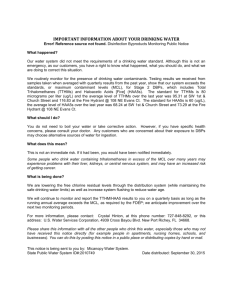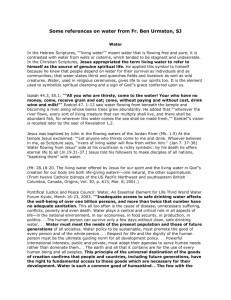Are You More Vulnerable to Drinking Water Contaminants?
advertisement
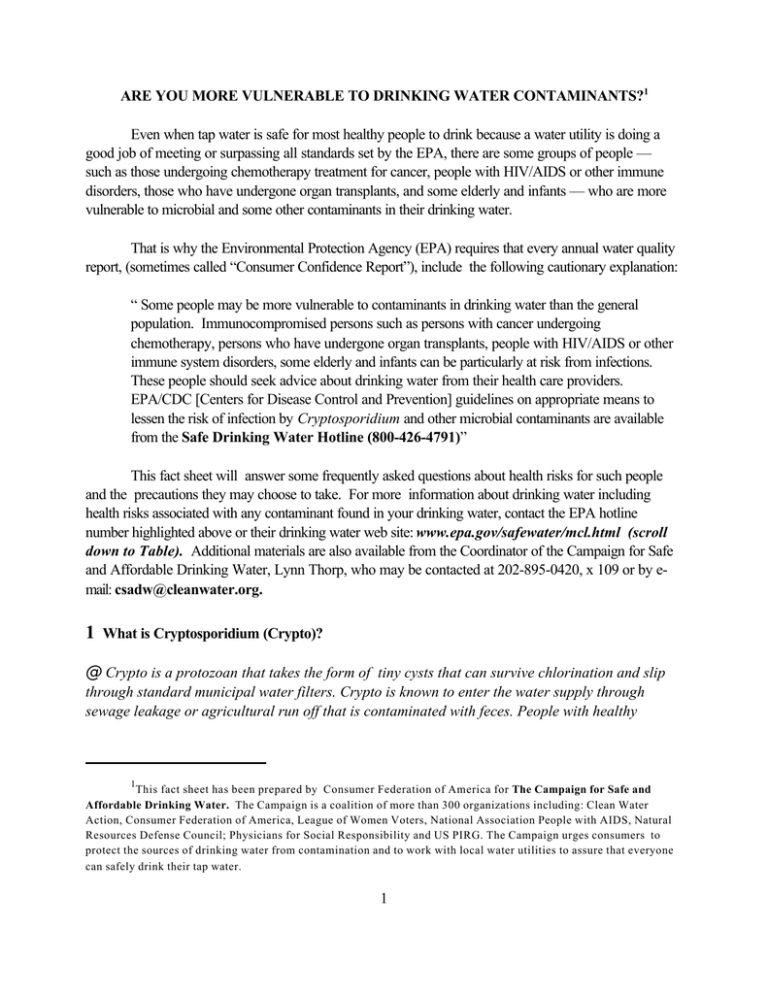
ARE YOU MORE VULNERABLE TO DRINKING WATER CONTAMINANTS?1 Even when tap water is safe for most healthy people to drink because a water utility is doing a good job of meeting or surpassing all standards set by the EPA, there are some groups of people — such as those undergoing chemotherapy treatment for cancer, people with HIV/AIDS or other immune disorders, those who have undergone organ transplants, and some elderly and infants — who are more vulnerable to microbial and some other contaminants in their drinking water. That is why the Environmental Protection Agency (EPA) requires that every annual water quality report, (sometimes called “Consumer Confidence Report”), include the following cautionary explanation: “ Some people may be more vulnerable to contaminants in drinking water than the general population. Immunocompromised persons such as persons with cancer undergoing chemotherapy, persons who have undergone organ transplants, people with HIV/AIDS or other immune system disorders, some elderly and infants can be particularly at risk from infections. These people should seek advice about drinking water from their health care providers. EPA/CDC [Centers for Disease Control and Prevention] guidelines on appropriate means to lessen the risk of infection by Cryptosporidium and other microbial contaminants are available from the Safe Drinking Water Hotline (800-426-4791)” This fact sheet will answer some frequently asked questions about health risks for such people and the precautions they may choose to take. For more information about drinking water including health risks associated with any contaminant found in your drinking water, contact the EPA hotline number highlighted above or their drinking water web site: www.epa.gov/safewater/mcl.html (scroll down to Table). Additional materials are also available from the Coordinator of the Campaign for Safe and Affordable Drinking Water, Lynn Thorp, who may be contacted at 202-895-0420, x 109 or by email: csadw@cleanwater.org. 1 What is Cryptosporidium (Crypto)? @ Crypto is a protozoan that takes the form of tiny cysts that can survive chlorination and slip through standard municipal water filters. Crypto is known to enter the water supply through sewage leakage or agricultural run off that is contaminated with feces. People with healthy 1 This fact sheet has been prepared by Consumer Federation of America for The Campaign for Safe and Affordable Drinking Water. The Campaign is a coalition of more than 300 organizations including: Clean Water Action, Consumer Federation of America, League of Women Voters, National Association People with AIDS, Natural Resources Defense Council; Physicians for Social Responsibility and US PIRG. The Campaign urges consumers to protect the sources of drinking water from contamination and to work with local water utilities to assure that everyone can safely drink their tap water. 1 immune systems may not become ill or, if they do, will usually recover within 7-20 days from Cryptosporidiosis (Crypto). Symptoms include: diarrhea, nausea, abdominal cramps, and a low fever. There is no medical cure for Crypto and it can be fatal for people with severely compromised immune systems. In 1993, Milwaukee experienced a major outbreak of Crypto (about 400,000 people were affected) that resulted in about 100 deaths, mostly among the immune compromised. Smaller outbreaks and individual cases occur each year and can cause severe weight loss and death in the immune compromised, such as people with HIV/AIDS. 2 How do I know if there is Crypto in my tap water? @ You don’t. Crypto is known to exist in 86% of lakes, rivers and streams. It also exists in some underground water supplies that are subject to surface contamination. Currently, there is neither an EPA maximum contaminant limit (MCL) for Crypto nor a required treatment to fully remove it. EPA plans to establish stricter standards and specific techniques for Crypto removal or disinfection by the year 2002. Water utilities may report that Crypto was not found in the treated water. Unfortunately, tests are not accurate enough to detect all Crypto cysts that can make you ill. If any Crypto is detected in either the source water or in water after treatment, it is prudent for the immune suppressed to take precautions such as those suggested in #5 below. (However the failure to find Crypto is no guarantee that it is not in the water.) 3 Are all elderly and infants more vulnerable to these infections? @ Probably not. Healthy older people and older children in good health are unlikely to be especially vulnerable. However, some vulnerable people may feel well but not be aware that the kinds of medical care they receive in order to stay well put them at risk of microbial infections. For example, long term and heavy use of steroids for arthritis and other conditions, and chemotherapy for cancer treatment, suppress the immune system and therefore makes one more vulnerable to a Crypto infection. Moreover, infants have immature immune systems and young children are subject to dangerous dehydration from Crypto-caused diarrhea. It is best to consult your health care provider if you have questions about the vulnerability of a particular child or elderly person. 4. Is it always safer to drink bottled water? @ No. Although the Food and Drug Administration(FDA) regulates all bottled water, it subjects that water to less rigorous testing and purity standards than the EPA requires for your tap water2. Moreover, FDA does not regulate bottled water that is packaged and sold only within a state even 2 NRDC, Bottled Water:Pure Drink or Pure Hype, 1999: www.nrdc.org/find/hebw.html . 2 though such water comprises 60-70% of all bottled water sold3. About 25% of all bottled water is municipal tap water (sometimes further treated, sometimes not). If you or someone in your family must drink an alternative to tap water, carefully read bottled water labels and the answers to #5 and 7 below. 5. What water is safe to drink for someone who is more vulnerable to Crypto and other waterborne microbial diseases? @ Tap water that has been boiled for one minute (not longer4);or @Bottled water that has been treated as follows:5 ‚ Distilled water (Preferred by many health care providers); or ‚ Other bottled water that has been filtered using reverse osmosis or an absolute one micron filtration system. Read the fine print on the label and call the company or National Sanitation Foundation (NSF)6 to confirm the treatment used; or @ Tap water that has been filtered in the home using a filter that is certified by the NSF to remove cysts (The label on the filter on the faucet or under the sink should read “NSF Standard #53 for cyst reduction.”7 ) It is important to change filters as frequently as directed because over time contaminants trapped by the filter build up and may enter and seriously contaminate your drinking water. 3 Call your state Health Department to learn if and how your state regulates bottled water. 4 At an altitude of 6,000 feet or higher, it is necessary to boil water longer than 1 minute. 5 Centers for Disease Control and Prevention (CDC) approved methods for Crypto removal. See also CDC’s web page: cdc.gov/ncidod/dpd/crypto.htm. 6 Or go to the California’s excellent listing of certified water treatment devices on the web at http://www.dhs.ca.gov/ps/ddwem/technical/certification/device/table.htm 7 Call NSF at 1-800-NSF-MARK or go to www.nsf.org to learn which brands of bottled water or models of water filters have the NSF certification for the type of treatment you require. NSF is an independent, not-for-profit organization that tests and verifies that each certified product meets all the requirements of the specified standard(s) and that the manufacturers’ claims are true. Be aware however, as a non-governmental group, its testing records are not open to the public and its certifications do not have the force of law. The Natural Resource Defense Council (an independent non-profit organization) conducted a large study of bottled water in 1998. Find the results on its web page: www.nrdc.org. 3 6. Are vulnerable people also at risk from any other contaminants in water? @ Yes. For example, lead, nitrates/nitrites and Total Trihalomethanes (TTHMs), are not only known to increase the risk of certain chronic diseases after long term exposure, they also can cause acute (immediate) adverse health effects in some groups of vulnerable people. There is also concern that organic chemicals in pesticides sometimes found in drinking water pose an increased health threat to children.8 This fact sheet only addresses the acute health effects of lead, TTHMs and nitrates. You can learn about both the chronic and acute health effects of any contaminant in your drinking water by accessing the Safe Drinking Water Hot Line 800-426-4791 or EPA’s web site, www.epa.gov/safewater. 7. If I want to protect someone not just from microbes but also from any other contaminants in the tap water, can I just use any of the same alternatives as listed in the answer to #5? @ Boiling water will not necessarily remove contaminants other than microbes. In fact, prolonged boiling (longer than one minute) will only increase the concentration in the water of contaminants such as lead and other metals, many chemicals, and nitrate. Contact the NSF or the California Department of Health Services (footnotes 5 and 6) for those brands of bottled water or home filters that are not only certified to remove Crypto cysts but also remove other specifically named contaminants that are reported to be in your tap water and that you wish removed. 8. What are nitrates and why are they a concern? @ Nitrates/nitrites are nutrients in nitrogen-based fertilizer and manure that are washed off the land into surface source water or enter some ground water from dissolved natural deposits. Nitrate levels in your water may rise quickly for short periods of time due to rainfall or agricultural activity. Nitrate is a health risk for fetuses and can cause the potentially fatal blue baby syndrome in infants of less than six months of age. DO NOT BOIL THE WATER to remove nitrates. Instead, use a carefully selected bottled water or a filter certified by NSF for nitrate removal. 9. Is lead in drinking water dangerous for children? @ Exposure to lead is not good for anyone. However, the fetus, infants and young children whose brains and nervous systems are still developing are particularly vulnerable to this toxic metal which may be found in lead paint, dust and some drinking water. According to the CDC, even low levels of lead are harmful and associated with decreased intelligence, impaired development and 8 The National Academy of Science’s Committee on Pesticides in the Diets of Infants and Children [National Academy Press, 1993] 4 decreased growth. Nearly 1 million children in the US have lead levels in their blood that are high enough to cause irreversible damage to their health.9 Lead in drinking water is primarily a problem of home plumbing or service connections; most drinking water leaves the treatment plant containing little or no lead. Corrosion of lead plumbing fixtures in older buildings or service lines, or leaching of lead solder used in the copper pipes of newer buildings, are the most frequent cause of lead in drinking water. (Since August 1998, all components of pipes and plumbing fixtures that dispense drinking water must be “lead free.”) 10. How do I know if lead is in my tap water? What can I do about it? @ Test the water from your own tap particularly if you are in an apartment or any high rise building where flushing the pipes (see below) may not be effective. Call the Safe Drinking Water Hotline (800-426-4791) for further information and a list of certified testing labs in your state. In addition to testing, and, if needed, purchasing a carefully selected filter or bottled water, there are immediate, inexpensive actions you can take to reduce potential exposure to lead in drinking water. It is especially important to take these precautions if you are pregnant or have young children: 11. ! First thing in the morning or whenever the tap water has been sitting in the pipes for hours, “flush” the cold water pipe by running the water until it is cold (30 seconds to two minutes). The more time water has been sitting in your pipes, the more lead it may contain. Do not waste the flushed water. Catch it in a container and use it to water plants or for any other non-cooking or non-drinking purpose. ! Use only cold water for drinking and cooking.(Hot water leaches more lead out of the pipes) Should I use tap water in my baby’s bottle? @ An infant is more vulnerable to microbial pathogens, and to nitrite/nitrates, lead, and many chemicals that may be in your tap water. Studies have found that as much as 85% of the blood lead in infants who are bottle fed may come from drinking baby formula with lead-contaminated water. A spike in nitrates in the drinking water may cause the “blue baby syndrome” as noted in #8 above. The safest and simplest options for feeding a baby are breast feeding or ready-mixed formula. However, if you know that your tap water is free of lead and nitrate/nitrite, you can reduce possible microbial contamination if you boil tap water for one minute (not longer; see answer to #7 above) before mixing it with dry formula. Remember to cool the water before feeding the baby! If lead or nitrates are in the tap water, a carefully selected filter or bottled water(see # 5 above) can be used for water in a baby’s bottle. Refrigerate any remaining bottled water after opening. 9 See web page www.cdc.gov/nceh/pubcatns/97fsheet/leadfcts/leadfcts.htm 5 12. I am pregnant or thinking about getting pregnant. Are there any drinking water contaminants in addition to nitrates and lead that can harm the fetus? @ Yes, Several studies have found that Trihalomethanes (TTHMs) in drinking water are associated with miscarriages and certain birth defects when consumed during the first three months of pregnancy. TTHMs are a group of contaminants that form in drinking water during treatment when disinfectant reacts with decomposing organic matter. The amount of TTHMs in tap water can vary from day to day and may be higher in some parts of the distribution system than in others. This may explain why even when the tap water does not surpass EPA’s maximum permitted level of 100 ug/L TTHMs as averaged over the course of a year, reproductive ill effects still may occur. A recent large scale California study assessed the risk of miscarriage for women drinking tap water containing TTHMs during the first trimester of pregnancy and found that some women who drank a lot of tap water that contained high levels of TTHMs (at least 75 ug or “micrograms” per liter of TTHMs) had a miscarriage rate significantly higher than those who drank less of that tap water or than those who drank tap water with lower concentrations of TTHMs. 13. How can I protect myself from TTHMs? @ Remember to drink lots of liquids during pregnancy and follow the advice of your health care provider. If you are concerned about TTHMs in your tap water, call your water utility, or look at your annual water quality report, to see if your tap water sometimes contains high levels of TTHMs. If it does, you have several options. Some experts suggest that you refrigerate tap water in an open container for several hours before drinking to allow TTHMs to leave the water and enter the air. Especially, if in addition to TTHMs, lead, nitrates or pesticides are a concern, it may be prudent to drink a carefully selected bottled water (check www.nrdc.org for bottled water test results and footnote 7) or water that has been filtered by a home system that has been certified to remove lead, nitrate and organic chemical contaminants. (See answer to #5) 6
